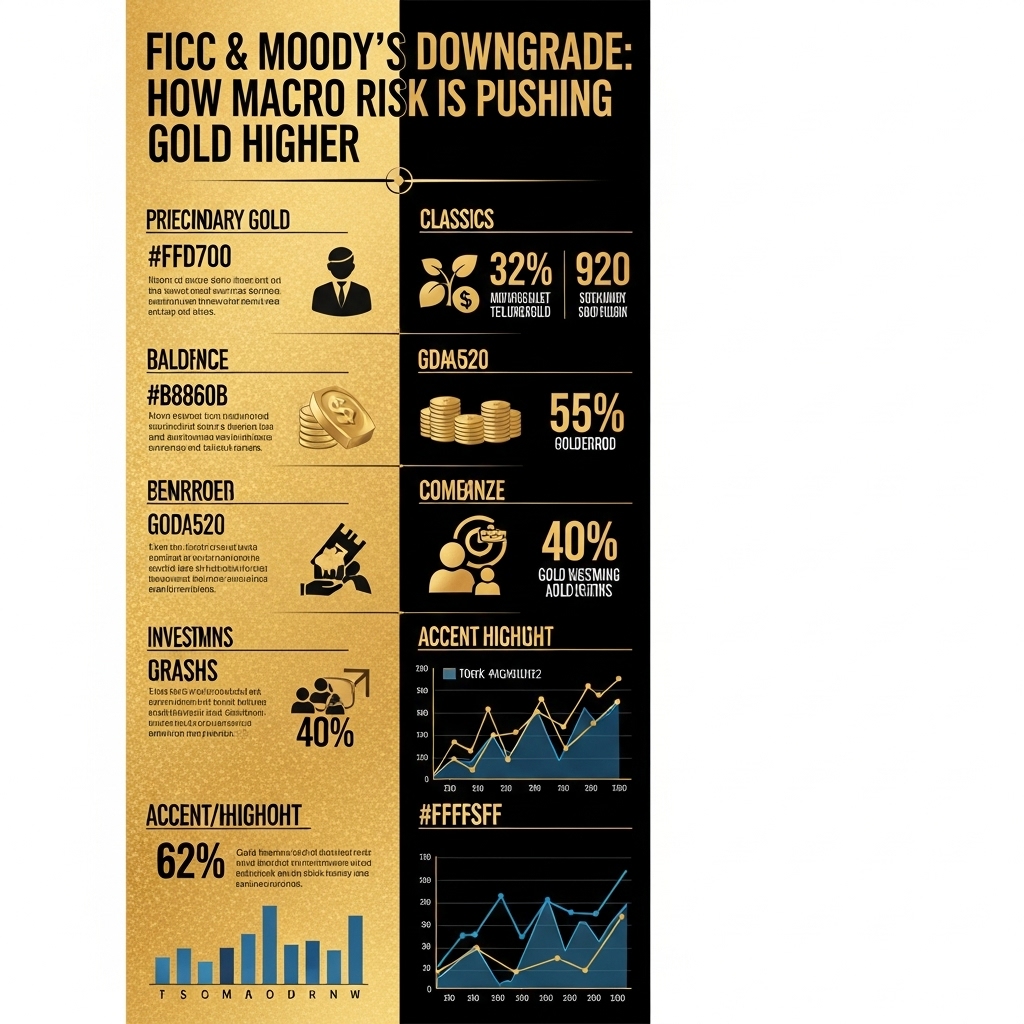Navigating Turbulent Waters: Gold’s Ascent Amidst Macro Risk
In recent times, gold has once again shone brightly, captivating investors with its resilient performance and upward trajectory. As traditional asset classes grapple with heightened volatility, the precious metal has not just held its ground, but surged, signaling a crucial shift in market dynamics. This isn’t merely a fleeting trend; it’s a direct response to a landscape increasingly shaped by systemic financial pressures and growing macroeconomic uncertainty. For astute investors, understanding the underlying drivers of this gold surge is paramount.
This post will delve into how significant developments like the recent Moody’s downgrade, alongside broader concerns within the Fixed Income, Currencies, and Commodities (FICC) markets, are directly fueling gold’s ascent. We’ll explore the intricate relationship between escalating sovereign credit risk and the flight to safety, demonstrating why gold remains the ultimate haven when confidence in conventional financial instruments wavers. You’ll gain insight into the specific mechanisms through which these macro headwinds translate into tangible upward pressure on gold prices.
For gold investors, comprehending these interconnected market forces isn’t just academic; it’s a strategic imperative. Recognizing how macro risks impact gold’s performance allows you to make more informed decisions, leverage emerging trends, and potentially enhance your portfolio’s resilience and profitability. Whether you’re a seasoned gold bug or considering your first allocation, this analysis will equip you with a clearer understanding of gold’s vital role as a hedge against instability and a powerful tool for preserving and growing wealth in an increasingly unpredictable financial world. Stay ahead of the curve – your portfolio may depend on it.
Gold Market Analysis and Key Insights
The FICC & Moody’s Downgrade Catalyst
The recent downgrade of the U.S. credit rating by Moody’s, and implicitly the broader Fixed Income, Currency, and Commodities (FICC) market sentiment, serves as a significant macro risk event. Historically, periods of heightened sovereign credit risk and economic uncertainty have seen gold emerge as a preferred safe-haven asset. This downgrade signals a potential erosion of confidence in the U.S. financial system, which could lead to increased demand for tangible assets like gold as investors seek to preserve capital.
Current Gold Market Trends and Data
Currently, gold prices are demonstrating resilience, trading near multi-year highs. Spot gold has shown a consistent upward trajectory, influenced by a confluence of factors including persistent inflation concerns, geopolitical tensions, and the aforementioned credit rating concerns. While specific data points fluctuate, the overarching trend indicates strong investor interest. ETF inflows have been notable, and central bank buying remains a steady supportive factor, further underscoring gold’s appeal in an uncertain macro environment.
Investment Benefits and Considerations
Investing in gold offers diversification benefits, acting as a hedge against inflation and currency devaluation. Its tangible nature provides a sense of security, especially during times of systemic financial stress. However, investors must consider gold’s inherent volatility and the lack of income generation (e.g., dividends or interest). Storage costs and the premiums associated with physical gold, as well as the potential for price dips during periods of risk appetite recovery, are crucial considerations.
Expert Recommendations
Many market analysts recommend maintaining a strategic allocation to gold within a diversified portfolio, particularly in the current macro climate. Experts suggest that the downgrade, coupled with ongoing inflation and geopolitical risks, provides a favorable backdrop for gold prices to continue their ascent. While short-term price movements can be unpredictable, the long-term case for gold as a store of value remains robust. Investors are advised to approach gold with a long-term perspective and to consider a mix of physical gold and gold-backed ETFs for balanced exposure.

Gold Investment Strategies and Options
Amidst escalating macro risks, including FICC instability and Moody’s downgrades, gold’s appeal as a safe-haven asset intensifies. Investors seeking to capitalize or protect wealth have several key avenues. Physical gold (coins, bars) offers tangible security and eliminates counterparty risk but incurs storage, insurance, and potential liquidity challenges. Gold Exchange-Traded Funds (ETFs) like GLD or IAU provide convenient, liquid exposure, mimicking gold price movements without the complexities of physical ownership. For those seeking leveraged exposure to gold price appreciation and broader equity potential, gold mining stocks or specialized mining ETFs (e.g., GDX) can offer higher returns, albeit with greater volatility and company-specific risks. Futures and options represent more sophisticated, leveraged strategies suitable for experienced traders due to their inherent complexity and risk.
For risk assessment and portfolio allocation, gold typically serves as a diversification tool and inflation hedge. A strategic allocation of 5-10% of one’s portfolio is common, depending on individual risk tolerance and the prevailing economic outlook. While physical gold offers ultimate counterparty risk protection, ETFs provide superior liquidity and lower costs. Mining stocks, by contrast, introduce equity market risk alongside gold price exposure.
Comparing investment methods, physical gold prioritizes tangibility over liquidity; ETFs balance liquidity with convenience; and mining stocks offer growth potential but higher volatility. Market timing for gold often correlates with macroeconomic indicators. Gold tends to perform strongly during periods of high inflation, negative real interest rates, geopolitical instability, and U.S. dollar weakness. Conversely, rising real interest rates or a strengthening dollar can exert downward pressure. Given current uncertainties, a long-term strategic allocation, rather than short-term tactical trading, is often recommended to harness gold’s intrinsic value as a store of wealth during periods of heightened macro risk.
Market Performance and Outlook
Gold has historically proven its value as a safe-haven asset, demonstrating resilience during periods of economic uncertainty, notably during the 2008 financial crisis and early pandemic. Currently, the confluence of FICC market stress and Moody’s recent downgrade of several US banks has significantly reinforced this demand. Despite rising interest rates, which typically pose a headwind, gold prices have shown robust performance in 2023, driven by a palpable increase in risk aversion.
The prevailing market conditions—marked by heightened systemic risk, concerns over bank liquidity, and a darkening sovereign credit outlook—are propelling gold higher. Investors are increasingly seeking refuge in the precious metal as a hedge against financial instability and potential currency devaluation. Economic factors such as persistent inflation, coupled with a volatile US dollar and ongoing geopolitical tensions, further bolster gold’s appeal.
Looking ahead, the outlook for gold remains constructive. Should macro risks persist or escalate, demand for safe assets will likely continue. Potential banking sector contagion or continued concerns over sovereign debt could drive gold prices to new highs. While a de-escalation of global risks or aggressive fiscal consolidation might temper its ascent, the current trajectory suggests gold will maintain its strength as a preferred haven asset amidst an uncertain global financial landscape.
Frequently Asked Questions About Gold Investment
Why is gold considered a safe haven asset during economic instability?
Gold often acts as a store of value. When traditional assets like stocks and bonds face volatility due to macro risks (e.g., credit downgrades, inflation, geopolitical tensions), investors flock to gold, perceiving it as a reliable asset that preserves wealth.
How do credit rating downgrades, like Moody’s, impact gold prices?
A sovereign credit rating downgrade signals increased risk and potential instability within a financial system. This erodes confidence in fiat currencies and government bonds, prompting investors to seek out alternative, safer assets like gold, thus driving up its price.
What is macro risk, and how does it influence gold’s appeal?
Macro risk refers to broad economic or political uncertainties such as high inflation, recessions, geopolitical conflicts, or significant interest rate shifts. These risks diminish the purchasing power of currencies and create market volatility, enhancing gold’s attractiveness as a hedge against such instability.
Does high inflation automatically mean higher gold prices?
Historically, gold has been considered a hedge against inflation. When inflation erodes the value of fiat currency, gold’s intrinsic value tends to hold, and its price often rises as investors seek to protect their purchasing power.
Should I invest in gold during periods of FICC market turmoil?
Turmoil in Fixed Income, Currencies, and Commodities (FICC) markets typically indicates broader financial system stress. During such times, gold’s role as a safe haven becomes more pronounced, as investors diversify away from risky traditional assets. However, all investments carry risk, and individual circumstances should be considered.

Final Thoughts on Gold Investment
The recent turbulence in FICC markets and Moody’s sovereign downgrade underscore a critical reality: heightened macro risk is a defining characteristic of today’s economic landscape. In an environment grappling with persistent inflation, elevated interest rates, and geopolitical uncertainties, gold’s intrinsic value as a safe-haven asset shines brighter. It serves as a proven hedge against market volatility and a reliable store of value when traditional assets falter.
For investors navigating these complex times, gold is more than just a commodity; it’s a vital portfolio diversifier. We recommend considering a strategic, measured allocation to gold, whether through physical bullion or reputable gold-backed ETFs, to fortify your portfolio against future shocks and preserve purchasing power. Don’t overlook gold’s protective qualities—evaluate its role in your long-term investment strategy and consult with a financial advisor today.